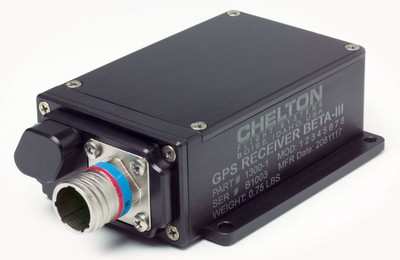New Gadgets For Fixed- And-Rotary Pilots
 March has certainly come in like a
lion for Chelton Flight Systems. Hot on the heels of Monday's
announcement the company will play a major role in developing the
next-generation Avio flight information system for the
Eclipse 500 VLJ, Aero-News has learned Chelton recently unveiled
two new products destined to make life a little better for pilots
in a wide variety of aircraft.
March has certainly come in like a
lion for Chelton Flight Systems. Hot on the heels of Monday's
announcement the company will play a major role in developing the
next-generation Avio flight information system for the
Eclipse 500 VLJ, Aero-News has learned Chelton recently unveiled
two new products destined to make life a little better for pilots
in a wide variety of aircraft.
Last week, Chelton unveiled a new Global Positioning System
(GPS) receiver featuring Wide Area Augmentation System (WAAS)
compatibility, for unparalleled accuracy and integrity monitoring.
Chelton says its new GPS-WAAS meets the requirements for a primary
(sole-source) navigation receiver for IFR enroute and precision
approach guidance. Weighing less than one pound, the new 15-channel
GPS-WAAS receiver is a fraction the size of competitors' products
allowing for ease and flexibility in the installation. Production
is expected to begin mid-summer 2007.
Powered by the NexNav GPS engine (jointly developed by
Spectralux Corporation and Accord Systems), the compact and
lightweight GPS-WAAS receiver is applicable to both fixed- and
rotary-wing aircraft. It provides 5 Hz position updates and 15
centimeter accuracy at full signal strength. Designed as a
stand-alone or display-integrated sensor, the receiver's
certification basis is TSO-C145b Beta 3, meeting specifications for
LPV approaches, and the new RTCA/DO-160E requirements for
environmental conditions.

"This new GPS-WAAS receiver not only provides a superior level
of performance and capability for our EFIS, but also affords us the
opportunity to integrate this module directly into the Chelton EFIS
product suite, thereby reducing space requirements and installation
time," said Chelton Flight Systems' President Gordon Pratt.
"Additionally, we are seeing significant interest in this product
for other applications requiring a high degree of performance at an
affordable price."
Chelton also launched a new combined digital air data and
strap-down solid-state attitude/heading reference -- that is 1/10th
the size, and 1/8th the weight of the two devices it replaces. Like
the new GPS, the ADAHRS is also designed for both fixed- and
rotary-wing aircraft -- and provides extremely precise digital
output and referencing of aircraft position, rate, vector and
acceleration data. It also interprets information from the
pitot-static system and an outside air temperature probe to
generate altitude, vertical speed, airspeed, and total air
temperature.
For accuracy, Chelton states the air data portion and attitude
portion are physically separated inside the enclosure by a
firewall, and do not depend on one another for operation. Dual
redundant power inputs and internal busses provide power to both
the air data computer and attitude gyro, leaving no single point of
electrical failure.

"The advantages of Chelton's AHADRS combining air data and
attitude/heading functionality are dramatic weight and space
savings, simplified installation, and improved reliability" said
Gordon Pratt, President of Chelton Flight Systems. "We are excited
to bring a reliable, precision sensor to the market, for both our
EFIS customers as well as any aircraft requiring a TSO'd AHRS and
Air Data Computer."
Chelton states the CFS ADAHRS is the only product in its price
range to feature the reliability of Level-A software in an all
digital, solid-state system utilizing Micro-Electro Mechanical
Systems (MEMS) in place of older-technology mechanical gyros. Mean
time between failure is estimated to be over 13,000 hours. The
ADAHRS product suite includes a remote Outside Air Temperature
(OAT) Probe and a Magnetometer Sensing Unit (MSU) in the standard
KMT-112 format.
The ADAHRS will form the core sensor suite for Chelton's EFIS
and HeliSAS helicopter autopilot and stability augmentation system,
and will begin shipping Q3 2007.
 ANN's Daily Aero-Term (05.05.24): Omnidirectional Approach Lighting System
ANN's Daily Aero-Term (05.05.24): Omnidirectional Approach Lighting System Aero-News: Quote of the Day (05.05.24)
Aero-News: Quote of the Day (05.05.24) Airborne 05.06.24: Gone West-Dick Rutan, ICON BK Update, SpaceX EVA Suit
Airborne 05.06.24: Gone West-Dick Rutan, ICON BK Update, SpaceX EVA Suit Airborne 05.03.24: Advanced Powerplant Solutions, PRA Runway Woes, Drone Racing
Airborne 05.03.24: Advanced Powerplant Solutions, PRA Runway Woes, Drone Racing Aero-News: Quote of the Day (05.06xx.24)
Aero-News: Quote of the Day (05.06xx.24)





